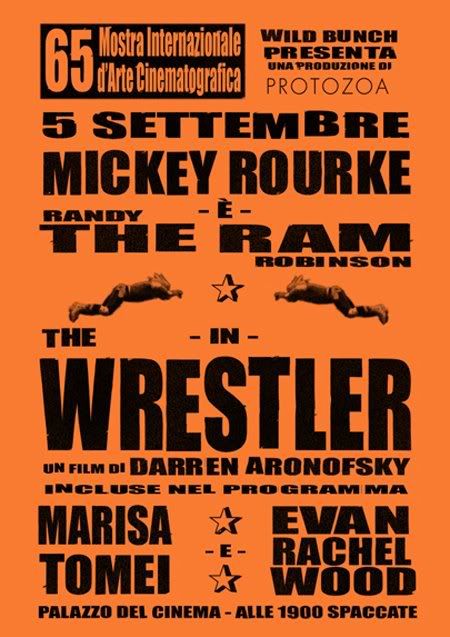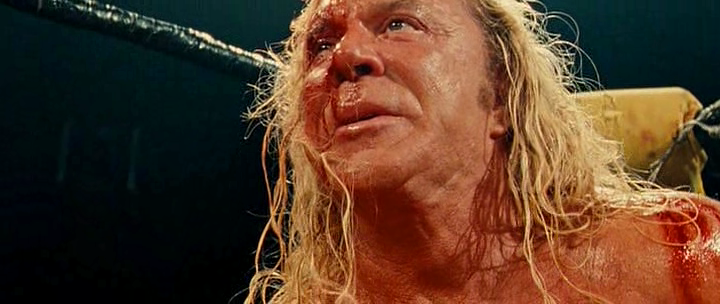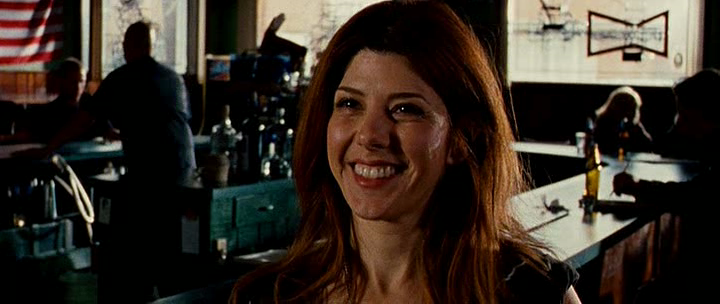
I remember the first time I saw No Country for Old Men: I came out of the theatre knowing I’d seen something, but I did not know exactly what that something was. I ended up seeing the film a further four times in the theatre and named it the best film of 2007. Watching Darren Aronofsky’s latest film, The Wrestler, provided what was essentially the opposite experience: I left the theatre with the very clear knowledge that I had just witnessed a masterpiece. The Wrestler is film at its finest.
The Wrestler tells the story of Randy “The Ram” Robinson. Twenty years ago he was a superstar in the world of pro-wrestling, but now he is resigned to living in a trailer, working at a grocery store, and exploiting his former fame to make money wherever he can. After a particularly brutal match, Randy suffers a heart attack and is told to give up wrestling. Now, merely a shadow of his former self, Randy begins a search for the human connection he has craved for years. The film follows this journey as he attempts to both romance a stripper at the club he frequents, and form a bond with his estranged daughter.
In Randy, we find a deeply conflicted man who cannot seem to reconcile his former life with his present reality. He holds on to memories of the past as closely as possible; in one scene, he dusts off his old Nintendo system and plays a game starring his wrestling persona The Ram against a kid from his trailer park. When the kid makes a comment about the latest video games on the market, Randy is at a loss. He is stuck in the 80s, right down to his hair and the music he loves: few people other than Randy would ever say that music from the 80s was “the best.”

The centrepiece of The Wrestler is Mickey Rourke’s gut-wrenching performance as Randy. The praise being heaped upon him is more than warranted. Rourke imbues every expression and movement with life. Many viewers and critics familiar with Rourke’s personal life have drawn parallels between Rourke and Randy, inferring that he was practically playing himself. The character’s situation may bear similarities to that of Rourke’s, but to say that the actor is merely playing himself denies him the credit that he deserves. In Randy Robinson, Rourke has created a complete person, and there is no other way to describe this accomplishment. Randy is not a mere character in a film: he is a flesh and blood person; teeming with emotion and sincerity and true humanity. Through Rourke, we are allowed to witness a real person searching for redemption and his place in the world. Some others have said it before me, but I will say it again: Mickey Rourke’s performance in The Wrestler is very easily one of the greatest performances ever captured on film.
Luckily, I am able to say that Rourke is not the only incredible thing about The Wrestler: Darren Aronofsky is just as much of a star. I haven’t really liked Aronofsky’s work in the past, mostly because I’ve found his films to be messy and seriously lacking emotion, but with The Wrestler, I feel he has found the perfect balance between his gritty realist style and the emotion inherent in the story and the lead performance. The cinematography is mostly handheld and the film is shot on grainy 16mm stock, which really helps to ground the film in reality. The editing is simple and never calls attention to itself, but is also extremely effective and powerful in many instances. There are a lot of shots from behind following Randy - and occasionally other characters - which help to give the impression of a star entering a room or an athlete entering a stadium. Through these shots, which are quite frequent, we see from the characters’ point of view while also delving into the deeper psyche of their relations to those around them. These kinds of stylistic touches are ever-present in The Wrestler and are beautiful to look at, yet add real substance to the film.
The Wrestler wouldn’t be a Darren Aronofsky film without some truly disturbing scenes and images. In The Wrestler, one particular scene comes to mind. Before the halfway mark of the film, Randy takes part in a wrestling match in which dangerous objects like a staple gun and barbed wire are used. The very gory bout is inter-cut with scenes from the dressing room after the fight in which the doctors aid with the clean up. The scene is not disturbing due to the violence, but the physicality of the images makes it difficult to sit through. We are essentially seeing a man torture himself through sport and every shot of the damage is painful and haunting. This is the scene that leads Randy to have a heart attack, and it’s really no wonder: by the end of it, I felt as though I was about to have one as well.

Randy’s love interest throughout the film is a stripper named Cassidy (Marisa Tomei). He continuously makes advances toward her, but she brushes them aside because she can’t be involved with a customer. Over the course of the film, their connection deepens and the characters grow to support each other as human beings. Tomei is excellent in this role and allows the character to rise above the cliché of the “stripper-with-a-heart-of-gold.” Her performance does not show the depth of Rourke’s, but it really doesn’t need to. She is there to play off of Rourke and to allow Rourke to play off of her, and at this, she is successful. At first, it might seem that making her character a stripper was unnecessary, but for this film, this aspect of her character is requisite for the connection between her and Randy: for both of them, there is a serious disconnect between life within their work and the stark reality of the world outside of it.
The other relationship that Randy pursues in the film is one with his daughter, Stephanie, who is in her twenties. Randy is not looking for forgiveness for his failings as a father, as he knows he won’t receive it, but he wants to move beyond their history and become a part of her life again. Evan Rachel Wood plays Stephanie and, unfortunately, she is the only weak link in the film. Her acting is rarely natural, relying too heavily on crutches such as nervous tics, and she doesn’t play well off of Rourke. Luckily for her (and for the film), those scenes still work incredibly well because of Rourke, who practically does the acting for the both of them. Because of this, the importance of her character and her scenes are felt very strongly. In one noteworthy moment, Rourke bares his soul to her, asking her simply not to hate him. I don’t think it’s possible for anyone in the audience to hate Randy, but we can easily see why Stephanie would and are left to hope that she can learn not to.
The last aspect of the film worth mentioning is Robert Siegel’s fantastic screenplay. The writing here is pitch-perfect; characters who would otherwise come off as two-dimensional are written with care and given humanity. The structure of the film is also magnificent: it may be simple, but it gives us a journey to redemption that is realistic and extremely rewarding. In certain ways, Randy even serves as a Christ-like figure. This is cleverly referenced in one scene in the film. There is an economy to Siegel’s writing that Aronofsky clearly understood and this comprehension translated very well into both the visual style and the editing of the film; the true greatness of The Wrestler may be that it finds such depth in realistic simplicity.

The Wrestler is a film layered deep in pain and emotion. It features a performance that will go down as one of the best in history, as well as confident direction and keen visual style. The film follows a very simple plot with few characters and a slow pace, but it delivers in a big way when it comes to character and theme. It is a powerful film in which every scene and almost every shot is filled with layers of meaning and subtext. I’ve only had the pleasure of viewing it once as of this writing, but I can’t wait to revisit it and see what I may have missed the first time around. The Wrestler is a must-see film and one of the best films of 2008.


You were clearly more enamored with the film than I was. It was without question of the better films released last year. However, I can't say I fell for either the daughter or the stripper plots. The daughter plot felt terribly run of the mill. The stripper plot was certainly better, but it obviously touched you more than it touched me. Tomei is good in the role, no doubt, but I didn't feel the script did her too many favors though.
ReplyDeleteAnyways, always a pleasure to read the hamster factor, hyperboles and all. You're full of yourself but that's what makes it fun.
great write-up, inspires me to check the film again. soon.
ReplyDelete-skjerva
I really like this sentence: Randy is not a mere character in a film: he is a flesh and blood person.
ReplyDeleteGood insight here:At first, it might seem that making her character a stripper was unnecessary, but for this film, this aspect of her character is requisite for the connection between her and Randy: for both of them, there is a serious disconnect between life within their work and the stark reality of the world outside of it.
I don't really believe there is any Christ-symbolism in the film; many do however. I'd be interested in you expanding on this in way of explanation.
It was a staple gun, not a nail gun! Thank God.
"It was a staple gun, not a nail gun"
ReplyDeleteFIXED!
With regards to the Christ symbolism: I think I saw it in Randy being a man taking a severe beating in life due to what he was seemingly put there for. I know that a lot of the Christ mythology lives or dies on whether he was a flawed individual, but I think the only way to make it work in the context of real life is to make the hero flawed. Randy is searching for his place in the world and no matter how much he tries he can't escape wrestling. I actually think the film is in many ways related thematically to the story as told in The Last Temptation of Christ in that way. It's not a direct interpretation of the story of Christ, but I felt it uses elements from it well.
I found another spelling mistake.
ReplyDeleteWhat's the mistake? And don't say centrepiece. That's how it's spelled in Canada.
ReplyDeleteI like your "Christ symbolism" take. If Cool Hand Luke is a Christ symbol (and he is) then I'm comfortable with the flawed character as such. The key to what you say is "taking a severe beating in life due to what he was seemingly put there for".
ReplyDeleteThanks for the explication.
What about Clint's character in Gran Torino? Same take?
Haven't yet seen Gran Torino. I'll probably catch it on DVD.
ReplyDelete@ Candace: Funny you mention Cool Hand Luke and Gran Torino - the title song for Torino reminds me so much of Cool Hand's "Plastic Jesus", to the point I get them mixed up. I don't think that was a mistake...
ReplyDelete-Rufish